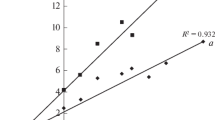Abstract
Growth inhibition ofMycobacterium phlei by tributylgermanium acetate can be reversed by addition of large amounts of blood or blood serum to the nutrient medium; the blood erythrocyte fraction is inactive.
On the other hand growth inhibition of the lactic acid bacteriaStreptococcus lactis andLeuconostoc mesenteroides can be counteracted by traces of blood or its crythrocyte fraction, by hemin and by catalase. Blood serum even in large amounts is ineffective.
Whereas tributylgermanium acetate is highly active against most lactic acid bacteria studied, the antagonistic action of blood or hemin is found only with the species named. The possible mechanism of this antagonism is discussed.
Similar content being viewed by others
References
Buijze, G. 1955. The carbohydrate metabolism ofLactobacillus brevis. Dissertation, Utrecht.
Christensen, M. D., Albury, M. N. andPederson, C. S. 1958. Variation in the acetic acid — lactic acid ratio among the lactic acid bacteria. Appl. Microbiol.6: 316–318.
Cremer, J. E. andAldridge, W. N. 1964. Toxicological and biochemical studies on some trialkylgermanium compounds. Brit. J. Industr. Med.21: 214–217.
Deibel, R. H. 1964. The group D Streptococci. Bacteriol. Rev.28: 330–336.
van den Hamer, C. J. A. 1960. The carbohydrate metabolism of the lactic acid bacteria. Dissertation, Utrecht.
Johnson, M. K. andMcCleskey, C. S. 1957. Studies on the aerobic carbohydrate metabolism ofLeuconostoc mesenteroides. J. Bacteriol.74: 22–25.
Johnson, M. K. andMcCleskey, C. S. 1958. Further studies on the aerobic metabolism ofLeuconostoc mesenteroides. J. Bacteriol.75: 98–101.
Jordan, R. M. M. 1952. The nutrition ofPasteurella septica. I. The action of haematin. Brit. J. Exptl. Pathol.33: 27–35.
Kaars Sijpesteijn, A., Rijkens, F., Luijten, J. G. A. andWillemsens, L. C. 1962. On the antifungal and antibacterial activity of some trisubstituted organogermanium, organotin and organolead compounds. Antonie van Leeuwenhoek28: 346–356.
Kaars Sijpesteijn, A., Rijkens, F. andvan der Kerk, G. J. M. 1964. Antimicrobial activity of trialkylgermanium acetates and the influence of the medium. Antonie van Leeuwenhock30: 113–120.
Kremer, M. L. 1965. Catalytic activity of haemin on the decomposition of hydrogen peroxide. Nature205: 384–385.
Lück, H. 1963. Catalase, p. 885–894.In H. U. Bergmeyer, [ed.], Methods of enzymatic analysis. Academic Press, New York.
Whittenbury, R. 1964. Hydrogen peroxide formation and catalase activity in the lactic acid bacteria. J. Gen. Microbiol.35: 13–26.
Author information
Authors and Affiliations
Rights and permissions
About this article
Cite this article
Kaars Sijpesteijn, A. Growth inhibition of bacteria by tributylgermanium acetate and its reversal by blood constituents. Antonie van Leeuwenhoek 34, 85–92 (1968). https://doi.org/10.1007/BF02046418
Received:
Published:
Issue Date:
DOI: https://doi.org/10.1007/BF02046418



